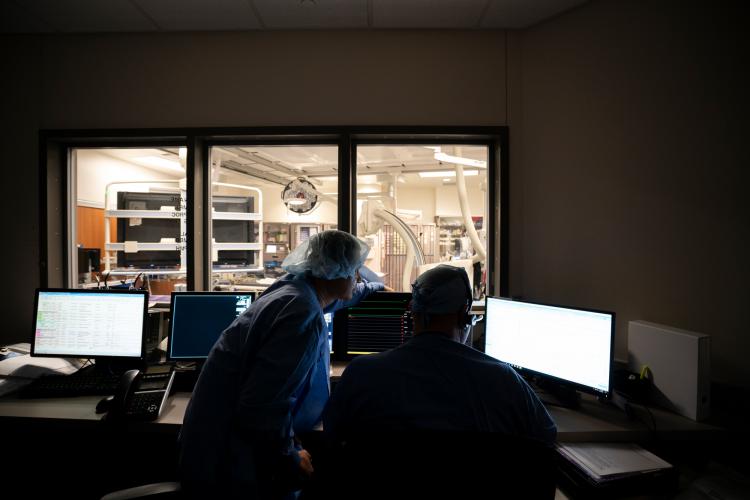
Understandably, patients don’t want to have to pay a visit to a cardiac catheter lab.
For people either in immediate cardiac distress or those weary after dealing with decreasing heart health over a period of years, having a catheter inserted into either the large blood vessels of your groin or your carotid artery is an unappealing but sometimes unavoidable situation.
The most urgent cases are those of patients who come into the Emergency Department suffering a heart attack. They’re whisked up to the lab feeling as if they have a massive weight on their chest that makes it difficult to breathe. A catheter with a balloon is pushed through their blood vessels to free up the blockage causing the problem, putting a seemingly miraculous end to a life-threatening episode. Instantly, their pain and sense of desperation turn into a sense of relief.
“We can’t cure heart disease,” cardiac catheter lab nurse Brittni Bailey, RN, BSN said. “But we can stop heart attacks as they’re happening. It’s an incredible feeling when we are able to save a life.”
Anne Goodrich, Executive Director of Cardiovascular Services, said a heart attack patient comes to the Cardiac Cath Lab at JPS about 120 times a year – or roughly once every three days. Bailey said no matter how many times she’s participated in the procedure, there is never a sense that saving a heart attack victim becomes routine. The members of the team live for the moment when “we got it” is announced in the lab, indicating that the blockage is clear and the patient’s heart is beating easier.
Robert Coleman, manager of Cardio Invasive Services, said there are only about 500 people in the United States who are qualified to clear blood clots from patients’ blood vessels in a cardiac cath lab. They’re prized by hospitals across the county and can have their choice of where they want to work because they’re so in demand.
According to Goodrich, the Cardiac Cath team typically includes four people, three in the room with the patient and one monitoring computer screens in a control booth. All the members are incredibly qualified, capable and dedicated. They’re constantly either on the job or on call for the next emergency case that comes through the hospital doors.
“We say ‘time is muscle’ when it comes to cardiac cases,” Goodrich said. “The faster we can get people in, the better it is for them. We have a team of incredible professionals who don’t get the recognition they deserve. It can be the middle of the night and they’re in their warm, cozy bed one minute. The next they’re getting their game face on because someone needs them and they have to get to the hospital.”
According to the Centers for Disease Control and Prevention, the number of people who die from heart attacks each year has decreased 38 percent since 2005. A decline in smoking and better management of cholesterol and blood pressure get some of the credit. But better and faster treatment are also difference makers.
By the time a heart attack has lingered on for two hours, vital heart tissue has begun to die. Because of this, hospitals across the country aim for a goal of 90 minutes from the time the patient comes through the hospital doors until the catheter balloon is deployed. Usually, a heart attack patient at JPS goes from diagnosis in the Emergency Department to delivery to the Cardiac Cath Lab in 12-17 minutes. From the time they come in the hospital doors until the balloon is deployed usually covers 50-70 minutes.
Invasive specialist Warren Mills described the scene with a patient who is actively dealing with a heart attack as “organized chaos.” He said the Cardiac Cath team operates with calm but deliberate action much like an auto racing pit crew.
While stopping a heart attack may be the most dramatic thing that happens in the Cardiac Cath Lab, it’s not the only thing. A variety of procedures take place in the room, many of them investigative in nature, according to Mills. Patients in heart failure or with irregular heartbeats might have a catheter procedure to test pressure within certain regions of their heart to help their doctor know exactly what’s going on so he or she can prescribe the best medicine to manage the problem.
A catheter can also be used to perform a cardiac ablation, which is a procedure used to eliminate an arrhythmia, otherwise known as an irregular heartbeat. Extreme heat or extreme cold can be delivered to the area of the heart where the unwanted impulse to beat originates, putting a stop to the problem at its source.
“People can come into the cath lab with a problem they’ve been struggling with for 30-40 years,” Mills said. “When they leave the room, they’re fixed for good. It’s amazing.”
